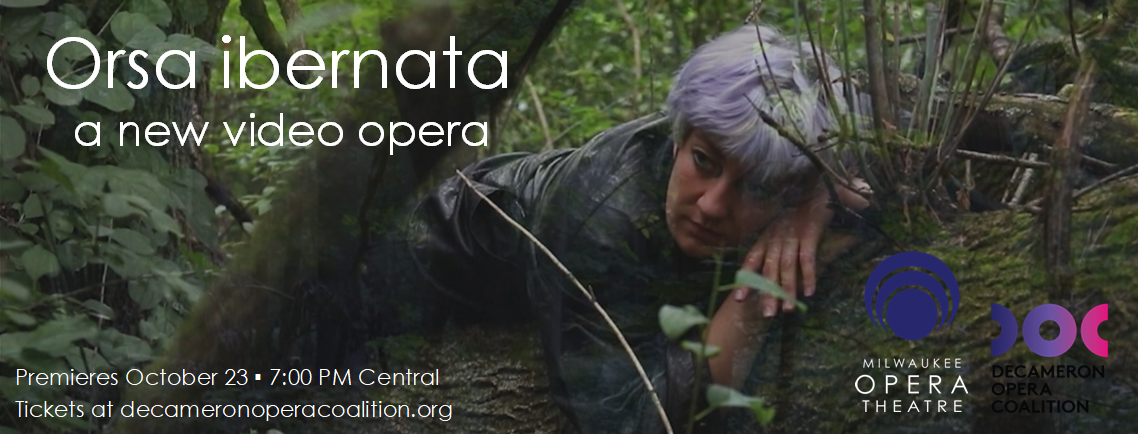From "Orsa ibernata" librettist and director Danny Brylow...

It was a random Friday afternoon in July when librettist Matt Boresi first approached us about creating a short video opera based on a story from the 14th century literary masterpiece, The Decameron. The finished product was to comprise one chapter in a multi-company, multi-part virtual opera anthology for the newly-created Decameron Opera Coalition. My interest was piqued, but I was also hesitant. With the deadline only three months away, it felt like too little time to conceptualize, adapt, write, compose, film, and edit a movie, even one that only lasted ten minutes! Over the next few days, Jill Anna and I emailed back and forth, deciding that we’d probably end up regretfully turning the project down. There just wasn’t enough time.
Just for grins and giggles, though…why not try something? What would happen if I just went to the Wikipedia page with the descriptions of all the stories in the Decameron, picked one at random, and explored the possibilities for adaptation? At the very least, it couldn’t hurt! I closed my eyes and scrolled up and down the page. I stopped, opened my eyes, and pointed to a story: Day 4, Story 9:
Sieur Guillaume de Roussillon slays his wife's lover, Sieur Guillaume de Cabestaing, and gives her his heart to eat. When she finds out, she throws herself from a high window, dies, and is buried with her lover.
Oh.
Well…that has potential.
I read on:
Filostrato tells this story, which has so many similarities with tale IV, 1 that both tales could have shared sources.
Over to Day 4, Story 1:
Tancredi, Prince of Salerno and father of Ghismonda, slays his daughter's lover, Guiscardo, and sends her his heart in a golden cup: Ghismonda, the daughter, pours upon it a poisonous distillation, which she drinks and dies.
Even more potential.
I unearthed my boyfriend’s tattered copy of The Decameron and read the two stories in full. The gears began to turn.
The director Robert Altman received the idea for his film 3 Women directly from a dream: plot, themes, imagery, and even casting choices came to him all at once. My process in conceptualizing what would eventually become “Orsa ibernata” wasn’t exactly like that, but it was pretty close. Inspired by the bare outline of the plot synopsis I had just read, several disparate questions came to mind:
How should I approach adapting the stories? Since we only had three months to complete the project and ten minutes of film time, the story would have to story relatively straightforward. What if we take a small slice of the plot – the very end where the female character commits suicide to be with her dead lover – and remove everything else? Would that work?
How should the story be expressed? In terms of words, music, and imagery, it just seemed intuitively right to explore the realm of the abstract and poetic. Would that yield the type of product I was looking for?
Where should we shoot? In the early days of the pandemic, I managed to keep sane by taking solitary walks in the woods near my home. I felt very connected to the woods, and to top it off, they even felt vaguely medieval, in keeping with the 14th century source material. Could that work for a shooting location?
Who should be involved? I’d worked with soprano Elizabeth Blood on MOT’s recent project, Utterance, and was dying to work with her again. I knew she wasn’t a composer, per se, but we’d had a conversation about her desire to explore music composition. Could it work for Elizabeth to compose music and perform as one of the characters? That way, we could keep the creative team small, allowing us to coordinate the project in the short time frame.
In the end, that’s pretty much exactly how it happened, except that early on, Elizabeth decided she wanted to play both characters, and we brought on videographer extraordinare Christal Wagner to shoot and edit. I’m incredibly proud to share “Orsa ibernata” with Milwaukee audiences, and thanks to the wonders of the internet, audiences around the country. Despite being completely sure we could never finish in time, I’m so glad we said yes to this project, so thankful for the support of the whole Decameron Opera Coalition, and most of all, grateful to Jill Anna for believing in my vision and helping me articulate it in just the way I envisioned those few short months ago.
Just for grins and giggles, though…why not try something? What would happen if I just went to the Wikipedia page with the descriptions of all the stories in the Decameron, picked one at random, and explored the possibilities for adaptation? At the very least, it couldn’t hurt! I closed my eyes and scrolled up and down the page. I stopped, opened my eyes, and pointed to a story: Day 4, Story 9:
Sieur Guillaume de Roussillon slays his wife's lover, Sieur Guillaume de Cabestaing, and gives her his heart to eat. When she finds out, she throws herself from a high window, dies, and is buried with her lover.
Oh.
Well…that has potential.
I read on:
Filostrato tells this story, which has so many similarities with tale IV, 1 that both tales could have shared sources.
Over to Day 4, Story 1:
Tancredi, Prince of Salerno and father of Ghismonda, slays his daughter's lover, Guiscardo, and sends her his heart in a golden cup: Ghismonda, the daughter, pours upon it a poisonous distillation, which she drinks and dies.
Even more potential.
I unearthed my boyfriend’s tattered copy of The Decameron and read the two stories in full. The gears began to turn.
The director Robert Altman received the idea for his film 3 Women directly from a dream: plot, themes, imagery, and even casting choices came to him all at once. My process in conceptualizing what would eventually become “Orsa ibernata” wasn’t exactly like that, but it was pretty close. Inspired by the bare outline of the plot synopsis I had just read, several disparate questions came to mind:
How should I approach adapting the stories? Since we only had three months to complete the project and ten minutes of film time, the story would have to story relatively straightforward. What if we take a small slice of the plot – the very end where the female character commits suicide to be with her dead lover – and remove everything else? Would that work?
How should the story be expressed? In terms of words, music, and imagery, it just seemed intuitively right to explore the realm of the abstract and poetic. Would that yield the type of product I was looking for?
Where should we shoot? In the early days of the pandemic, I managed to keep sane by taking solitary walks in the woods near my home. I felt very connected to the woods, and to top it off, they even felt vaguely medieval, in keeping with the 14th century source material. Could that work for a shooting location?
Who should be involved? I’d worked with soprano Elizabeth Blood on MOT’s recent project, Utterance, and was dying to work with her again. I knew she wasn’t a composer, per se, but we’d had a conversation about her desire to explore music composition. Could it work for Elizabeth to compose music and perform as one of the characters? That way, we could keep the creative team small, allowing us to coordinate the project in the short time frame.
In the end, that’s pretty much exactly how it happened, except that early on, Elizabeth decided she wanted to play both characters, and we brought on videographer extraordinare Christal Wagner to shoot and edit. I’m incredibly proud to share “Orsa ibernata” with Milwaukee audiences, and thanks to the wonders of the internet, audiences around the country. Despite being completely sure we could never finish in time, I’m so glad we said yes to this project, so thankful for the support of the whole Decameron Opera Coalition, and most of all, grateful to Jill Anna for believing in my vision and helping me articulate it in just the way I envisioned those few short months ago.
"Orsa ibernata" is available to stream until the end of the year!
Tickets still available!
Learn about Composer and Performer Elizabeth Blood's creative process.
Tickets still available!
Learn about Composer and Performer Elizabeth Blood's creative process.


